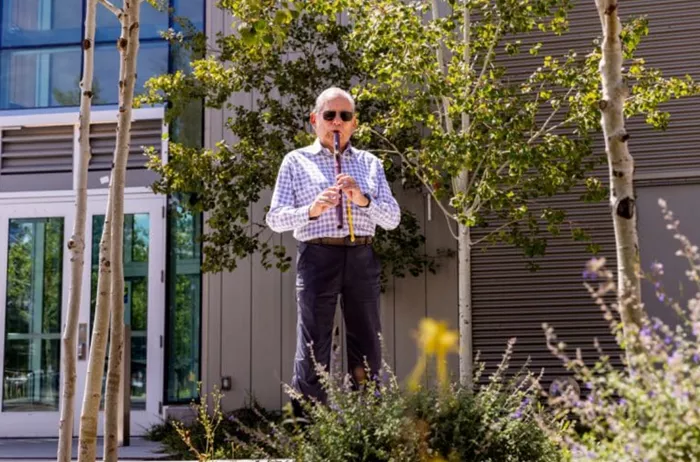A new campus space, Nakai Plaza, has been created between Kitt Recital Hall and the Clifford E. White Theater, thanks to a generous donation from Nakai and his wife, Pamela Hyde-Nakai. The plaza, now a peaceful area filled with native plants, is designed to celebrate cultural connections and foster engagement with nature.
For Nakai, the plaza serves as a reminder of the importance of creating spaces that both educate and connect people to Indigenous culture. “This area is at the heart of music, and we want to encourage a deeper connection to native plants while providing a space where Indigenous people can feel at home, at the center of both music and nature,” Nakai said. “By showing our sense of belonging and inviting students to be part of it, we create a space that brings us all together.”
Nakai, considered one of the foremost Native American flutists today, is best known for his platinum-certified album Canyon Trilogy, released in 2014. With a career spanning 40 years, Nakai has released over 50 albums, selling more than 4.3 million copies worldwide. He has been nominated for a Grammy 11 times in four different categories. Nakai graduated from Northern Arizona University (NAU) in 1979 and was awarded an honorary doctorate in 1994.
Nakai Plaza features a variety of plants native to the region, including golden columbine and blue catmint. The space was developed in collaboration with local master gardener Laura Davis, long-time friend Phyllis Hogan, and NAU Greenhouse manager Adair Patterson. The plants were grown at the Museum of Northern Arizona to enhance the area with Indigenous flora.
At the plaza’s dedication ceremony, Nakai, Hyde-Nakai, and NAU staff were joined by forestry and fire ecology student Sahale James, who blessed the space and shared information about the various plants. James, a Navajo student, spoke about his research and how it has deepened his connection to the plants, both from a scientific and cultural perspective. “As a student of forestry, learning about these plants helped me connect with them on a deeper level, both for their medicinal uses in Western science and in my own cultural traditions,” James said. “I’m proud to share this knowledge with other Native American students and advocate for our culture.”
Related topics:
- Key Grower Trends to Watch for in 2025
- Kind Earth Growers: Making Native Plants Mainstream
- Study Reveals How Non-Native Plants Fuel Invasive Insect Surges


